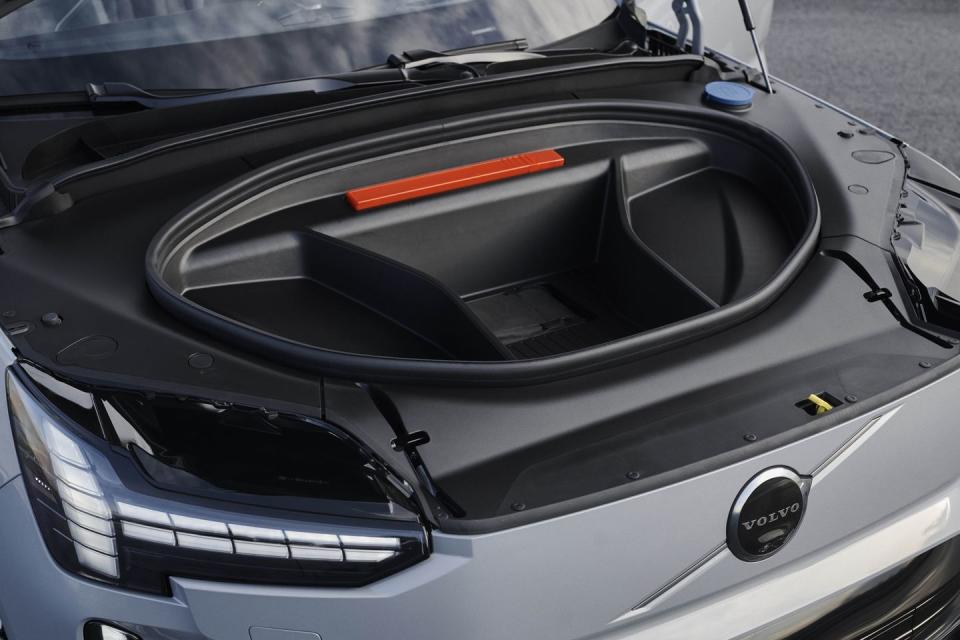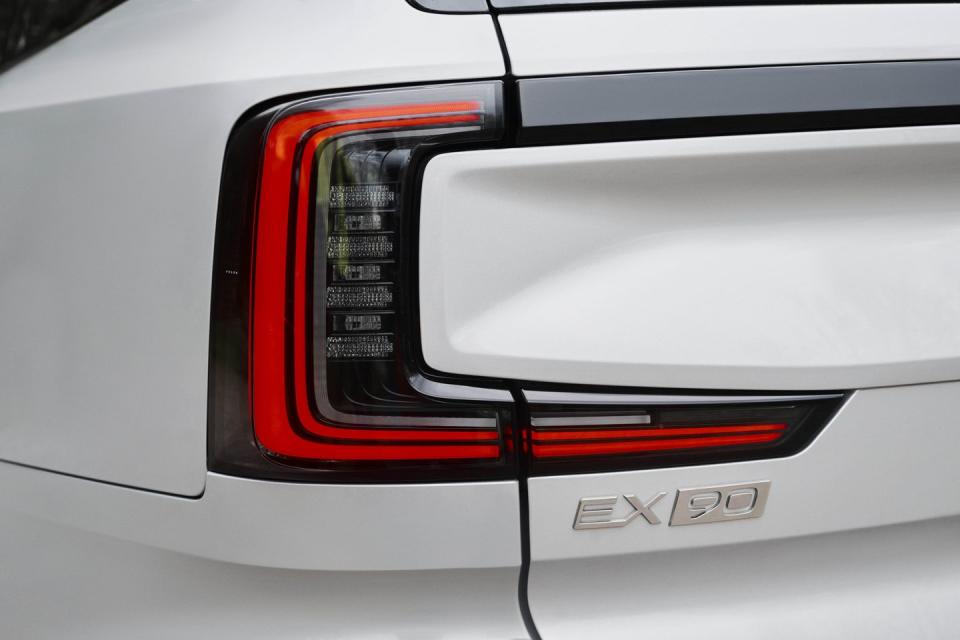2025 Volvo EX90 First Ride: The Silent Treatment

The first thing we notice riding in a pre-production version of the all-new electric Volvo EX90 three-row SUV is the silence. Unlike most of its battery-electric competitors, during acceleration it does not pipe in a soundtrack that mimics an internal-combustion engine, or a retrofuturistic spaceship, or a turkey imitating a theremin.
Ever and blessedly rational, Volvo does not see the need for this type of skeuomorph, like the candle-shaped light bulbs on an electric chandelier or the shutter click of a cellphone camera, to help our reptilian brains make a technological leap. With this car, the brand is attempting to create its quietest cabin ever, so adding sound output was counterproductive.
This encapsulates the logical philosophy that underpins Volvo's first, and important, entry into the electric three-row SUV market. The predecessor to this vehicle, the XC90, has long been the brand's flagship, typically vying with the mid-size two-row XC60 in recent years as its bestseller. So, while its entry-level EX30 EV is key for converting buyers new to electric cars (and to the marque), success for the EX90 is a top priority for the bottom line.
Lead vehicle-dynamics engineer Mattias Davidsson chauffeurs us around the Volvo's Hällered Proving Ground. He says the EX90's brief was to be "predictable, controllable, and comfortable," with a notable emphasis on the cushy end of the spectrum. "As our flagship SUV, the EX90 is intended to be the most comfortable vehicle in our lineup," he says, as he blasts over sections of roadway that mimic European cobblestone streets, L.A. freeway expansion joints, and the raised cast-iron thunk-thunk of New York City manhole covers.

A new computer-actuated dual-chamber air suspension helps the EX90 feel refined, flat, and planted despite heinous tarmac infirmities. It exhibits the same characteristics during small maneuvers at high speed, a sensation we experience when Davidson worms the wheel on Hällered's high-speed track. An evolution of the single-chamber system that's been available on the XC90 and XC60, the setup has an ECU that allows for instantaneous reactions to road imperfections. In tandem with hydro-bushings in the front and rear axle, it further enhances longitudinal damping, counteracting suspension-crashing sensations. The 107.0-kWh underfloor battery aids in lowering the center of gravity and centralizing inertial mass, increasing the perceived sense of stability because, you know, physics. "We prioritized directional stability and linear feel," Davidson says. We aren't driving, but our cranial and gastric-fluid dynamometers registered a noted placidity.
There are only two settings for the suspension (and the steering), soft and firm. Not surprisingly, given the vehicle's mission, compliance is the default, and that's not a bad thing. The firmer setting seems only to increase intrusion, something the SUV's other four, five, or six passengers aren't likely to appreciate. A trick torque-vectoring system, new to Volvo, recognizably enhances agility in low-speed or low-traction situations and aids in takeoff performance. But the EX90 does not crab walk or spin in circles. This is a Volvo, and despite that its hometown hosts Northern Europe's largest amusement park, the brand rejects big carny energy.

Speaking of energy, we don't know yet what the EPA will say about the EX90's range, though Volvo is guessing around 300 miles for the most parsimonious model, which has the 402-hp Twin Motor all-wheel-drive powertrain. Volvo estimates that version should reach 60 mph in about 5.7 seconds. The 510-hp Twin Motor Performance model, in which we rode, should hit the mile-a-minute mark about a second quicker than that, though range will suffer accordingly.
The lack of clowning continues in the cabin, where everything is presented in a decidedly Scandinavian-modern idiom. The backlit bent wood veneers are Alvar Aalto–esque, clutter is vanquished, and storage is multifarious, with bins and cubbies including a frunk, a handbag shelf beneath the center console, and a subcompartment beneath the rear cargo floor. The overall footprint, cabin and passenger-compartment dimensions, and even the silhouette closely mimic the XC90. This is a bit of a shame, given the supposed liberation from design convention evinced by EVs, especially since Volvo taunted us with its stellar Concept Recharge a few years back.

Were we ordering an EX90, we'd definitely opt for the premium gray tailored "wool" interior, though this material is actually made of woven recycled polyester, part of Volvo's commitment to sustainability. Likewise, the "leather" option is a kind of vinyl made from pine oil and some other schmutz. Both look lovely and airy in the big-windowed, glass-roofed cabin, though if we were going for the fake-leather Nordico, we'd elect the lighter sand color; the black looks somehow cheap.
One thing we are very glad to see Volvo avoiding is the proliferation of screens, which we think is not only ugly but also boring and needless since all passengers above the age of 18 months likely already have a screen in their hands or pocket. A 14.5-inch screen in the middle controls virtually everything, including simple functions like adjusting the side mirrors and HVAC, and opening the glovebox and trunk. Our complaints about this were rebuked by Volvo UX experts, who claimed that research shows that tiny touchscreen menus are superior to hard buttons. We expect that their focus group consists solely of the Volvo UX experts who built the system.
Also, unlike in the smaller and narrower EX30, there is a demi-iPhone-sized screen above the steering column, the better to spy on the driver. It incorporates a speedometer as well as Volvo's new multicamera driver-monitoring system. This is part of the suite of lidar, radar, eight cameras, and 12 ultrasonic sensors that collaborate to enforce Volvo's "zero crash" intent for this vehicle.

These systems are also part of the brand's preparations for the evanescent onset of autonomous driving. Onboard redundancies in the EX90's automated braking, steering, and power-delivery systems also exist in the vague hope that regulation, technology, human adoption, and cultural norms will eventually allow for driverless cars. All of these supernumerary systems, along with the big battery, help explain the EX90's three-ton-plus curb weight. At least you can store energy in its hefty battery cells and use them bidirectionally to power your house or electrical accessories. Don't expect to be able to jump-start another EV just yet, though Volvo spokespeople suggested that might also be coming someday.
For those who are not ready to transition to an EV, Volvo says it will continue to produce and update its XC90 for as long as demand persists.
Volvo is known for safety, stolidity, and, increasingly, premium sustainable materials. The EX90 is not a driver's car. But it excels at what it sets out to do, which is provide all of the above attributes in a handsome package. If you're looking for a three-row electric SUV to Goldilocks itself between a Kia EV9 and a Mercedes EQS SUV, while providing a blend of both, without the faceted retrofuturism or lavish baroqueries of either, you may have found your ride.
Like most Volvos, it looks and acts exactly like a Volvo, and we approve of and appreciate that. Check back with us later this summer when we have the chance to drive it for ourselves and see what all the not-hubbub is about.
You Might Also Like

 Yahoo Autos
Yahoo Autos 